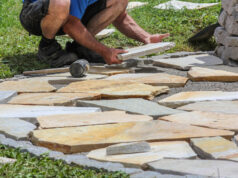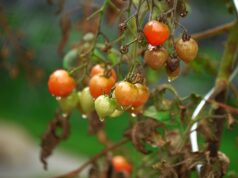While there are many premade composting systems on the market, store bought compost bins and buckets are often expensive and too small to produce the large volumes of compost backyard gardeners need to keep their gardens lush and happy. Luckily, by following a few simple steps, you can quickly and easily build your own DIY backyard compost bin that will suit any budget. With its simple but effective design, your homemade compost bin will have you producing rich, garden-ready compost in no time.
Composting fundamentals
Composting works by creating an ideal environment for nature’s decomposers – such as earthworms and beneficial bacteria – to thrive. The healthier these decomposers are, the quicker they are able to break down organic matter, turning yard waste and kitchen scraps into nutrient-dense compost in as little as four weeks.
Gardeners today have several different composting methods to choose from. Bokashi is a popular form of composting that utilizes fermentation to break down organic matter, while vermicomposting relies on the use of red wiggler worms to degrade food scraps quickly. However, when most people think about composting, they think about the hot composting method. And with good reason. Hot composting allows home gardeners to produce large volumes of quality compost in a short period of time.
Why hot composting?
Hot composting relies on the combination of nitrogen and carbon-rich organic matter at a rate of three parts carbon-rich material (such as sawdust, brown leaves and twigs) to one part nitrogen-rich material (such as vegetable peels, chicken manure and grass clippings). Compost piles are then regularly turned to maintain airflow, generally about twice a week, and temperatures are monitored with a compost thermometer to ensure piles remain at an ideal temperature range of between 141 and 155°F. Piles are also regularly moistened so that they maintain the consistency of a rung sponge.
Hot composting is a preferred composting method because it creates large quantities of compost, but that’s not the only reason many gardeners prefer it. Because hot compost piles generate heat, they are also able to kill off many weed seeds and soil-borne pathogens, resulting in nutrient-rich compost that can be applied directly to garden beds.
Creating a simple backyard compost bin with wooden pallets
One of the simplest DIY backyard composting systems you can build repurposes old wooden shipping pallets. The standard wooden pallet measures approximately 40” x 48”, making it the perfect size for hot composting, as hot compost piles need to be at least 3’ square to generate enough heat.
Old shipping pallets can often be found for free at local box stores or by searching online groups and classified ads. When selecting your pallets, make sure they have not been treated with chemicals. Untreated pallets will be marked with “HT,” signifying that they have been treated with heat and are safe to use. Any pallets marked “MB” have been treated with a toxin known as methyl bromide and are not safe to use in gardens.
What you need:
- Shovel
- Rake
- Power drill
- Staple gun and staples
- Wire cutters
- 4 untreated wooden pallets
- Screws, at least 2 ½” to 3” long
- 6 galvanized steel corner braces, similar to this
- Hardware cloth
- A garden gate latch (optional)
- 2 garden gate hinges (optional)
Building your bin
Step 1: Selecting your site
The first step towards building your DIY composting bin is selecting a proper site for your composting station. Many gardeners opt for a sunny spot near their garden to ensure proper temperatures and ease of access when it’s time to use your compost. Access to a garden hose is also recommended to ensure a ready source of moisture to prevent your compost from drying out.
Step 2: Prep your area
When you’ve selected your site, rake away any debris and use your shovel to remove any large stones and any high spots. Your compost bin does not need to be perfectly level, but large irregularities in the soil should be removed.
Step 3: Add hardware cloth
Adding hardware cloth to your compost bin is optional but recommended. Hardware cloth not only keeps your bin cleaner by preventing waste from slipping through the pallet slats, but it will also help keep garden pests away.
Measure and cut four panels of hardware cloth to fit each of your four pallets using your wire cutters. With your staple gun, staple the edges of your hardware cloth to one side of each of your pallets.
Step 4: Secure your pallets together
Using your corner braces and screws, fasten two pallets together in an L-shape attaching three braces on the inside corner to ensure your pallets are secured. Attach your third pallet to the opposite side, forming a u-shape, again securing the inner corner with three more braces and screws. Be sure that each pallet is aligned so that the side with the hardware cloth is facing inwards.
While some may choose to add an additional pallet to the base of their compost bin, it is not needed. Allowing your compost pile to touch soil encourages the growth of beneficial decomposers resulting in quicker processing times.
Step 5: Add a door
Your fourth pallet will act as the door to your compost bin and will work to keep your compost in and pests out. For an easy solution, simply tie one side of your fourth pallet to the bin structure with twine. For a more permanent solution, fix your door to your bin structure with gate hinges and a garden latch.
If desired, a tarp or corrugated plastic sheet can be attached to the top of your compost bin to keep out rain, but this is not necessary.
Using your compost bin
When you’re ready to use your homemade bin, alternate layers of nitrogen and carbon-rich organic matter in your bin, always making sure to top your pile off with soil or carbon-rich material last to eliminate any unpleasant odors.
Using a pitchfork, turn your pile at least twice a week, ideally whenever you add new kitchen scraps or garden waste. Monitor the temperature of your pile regularly with a compost thermometer so that your pile retains a consistent temperature of between 141 and 155°F. If temperatures begin to drop, be sure to turn your pile to improve aeration. If your pile seems too dry, add water to achieve the consistency of a wrung sponge. If your compost starts to smell, mix in more carbon-rich material like sawdust or dried leaves.
After about four to six weeks, the temperature of your compost pile will begin to drop, signifying that the decomposition process is coming to a halt. You’ll know your pile is done when items added to the pile are no longer identifiable and you have produced a compost that smells rich and sweet and resembles dark earth.
Expanding your bin into a three-bin composting system
While the above set up works well for most small gardens, if you want to generate compost more quickly or you have a large quantity of yard or kitchen waste, this simple design can easily be expanded into a larger three-bin system.
To expand your compost bin, create an additional two compost bins by affixing four more pallets to your original design. Hardware cloth should be stapled to the inside of each pallet before attaching the pallets together with additional braces and screws. You can choose to add doors to each of your bins or leave the fronts open for easier access.
Using your three-bin composting system
Three-bin systems work essentially the same as a single bin system; however, because of the additional bins and space, you can process more organic matter at once and don’t need to turn piles as frequently.
Employing the same methods used in a single bin composter, add all organic matter to the first bin of your three-part system, turning the pile several times over the course of two to three weeks. When the organic matter begins to breakdown, move your pile to the second bin and allow it to age several more weeks. Your now-empty first bin can be used to start the cycle over with additional kitchen scraps and yard waste. Piles are turned and moved to the subsequent bin as they age, finally finishing composting in the third and final bin.
Conclusion
Backyard composting can be as simple or as elaborate as you choose. While some may opt for store bought composters, a basic upcycled pallet compost bin is both easy to build and budget-friendly. Because of its simple design and utility, this basic composting system will fit most gardener’s needs and can produce high quality compost in a matter of weeks. By turning old kitchen scraps and garden waste into nutrient-rich compost, you’ll not only save money but also eliminate the need to rely on synthetic fertilizers to grow an abundant harvest.








